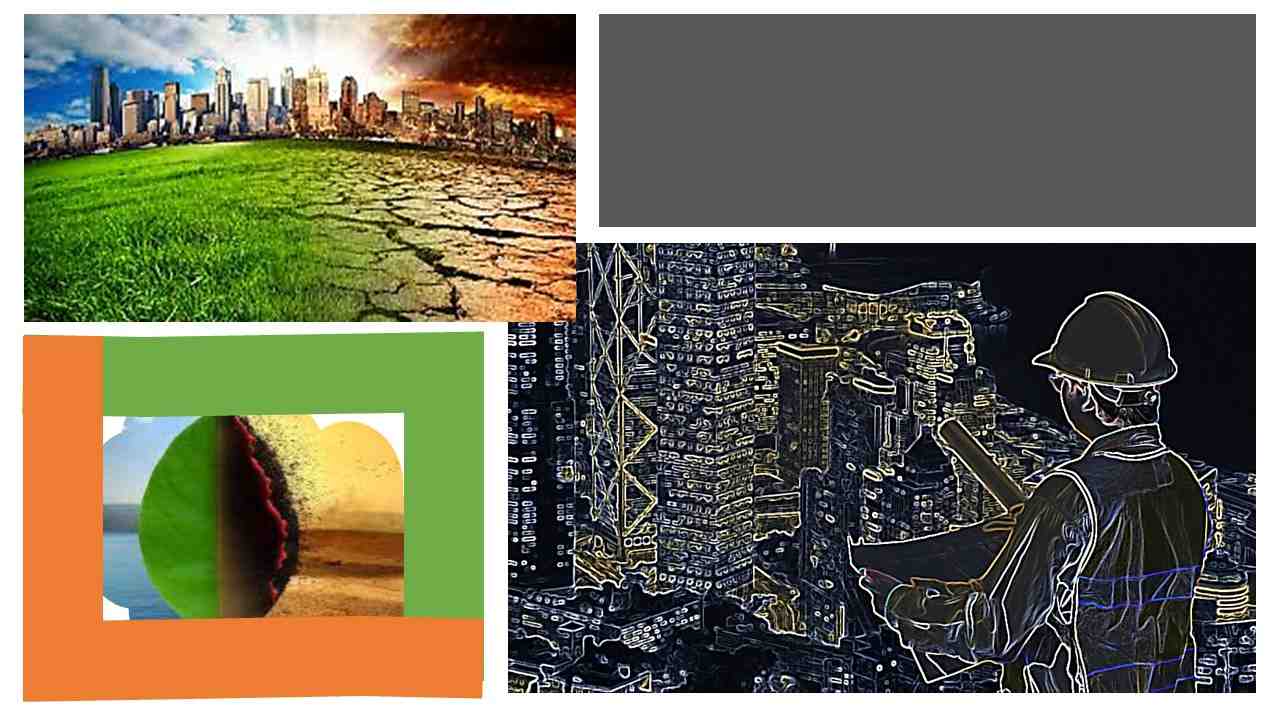Impact of climate change on Civil Engineering
- By
- Pooja |
- December 08, 2022 |
- Civil Engineering,

Table of Contents
Climate Changes and Civil Engineering
Design Load Impact on Climate Change
Effect of Temperature Variation on the Structure
Impact of Increased CO2 Emissions on Structures
Impact of Increased Sea Level on the Structures
Global warming, the observed rise in the climate system's average temperature and its consequences, is a recent phenomenon. The Earth's average temperature has risen rapidly in the previous 50 years. Temperatures have risen most in the last 20 years. Recent years have seen a tremendous rise in evidence of climate change from atmospheric and surface data, according to the IPCC.
These advancements have improved our understanding of the problems. Between 1880 and 2010, global land and ocean temperatures rose 0.85 °C. Rising temperatures have natural and manmade causes. The climate system can cause short-term changes. External forces include greenhouse gas increases, solar brightness fluctuations, and volcanic eruptions.
Human activity significantly influences climate change. Rising greenhouse gas levels, positive radiative forcing, and warming show this. IPCC says the warming since the mid-20th century is almost certainly human-caused.
Climate Changes and Civil Engineering
Secondary effects include deterioration and corrosion, changes in structure load from rising sea levels or temperature fluctuations, and increased wind and snow load. Civil engineers must factor in constant change at every stage of the design and build processes. Civil engineering researchers, practitioners, and educators battle and accept climate change.
Increases in the concentration of greenhouse gases in the atmosphere, such as carbon dioxide, also lead to an increase in average global temperatures. Cement production accounts for a significant portion of the emissions from the civil engineering sector. The rising number of concrete structures in recent years has contributed to an increase in CO2 emissions, which in turn increased cement production in response to a rise in cement demand.
A dramatic increase in CO2 emissions is attributable to the usage of fossil fuels and the production of cement. The year 2015 marked a turning point in the history of cement production emissions, as major polluters such as China and the United States were able to reduce their emissions by 0.7% and 2.6%, respectively, from 2014 levels.
Regardless of this decrease, cement production is expected to contribute to increased average CO2 emissions over the next few decades. Given these forecasts, it's clear that civil engineering structures are the big contributor to GHG emissions, and that finding a way to reduce cement production is an urgent need.
Design Load Impact on Climate Change
Civil engineers must now estimate the design load influence of climate change on structures. Structures and their key components, such as claddings and roofs, must withstand some forces. In structural design, the predicted load is smaller than the design load. Because a margin of safety is built into the system's design, it can tolerate loads.
A system's safety factor is its ability to withstand extra stresses. Statistics and predetermined impact probabilities are commonly used to establish design loads, with the resulting designs being produced from standardized practices (ASCE rules, EC, BSI, etc.). Using a limit state design technique where loads are matched with combination factors, a structure can resist all expected activities over its entire design life with an adequate level of dependability for each limit state.
During the planning stage, the load factors are utilised to model the actual load from a variety of sources. Coefficients change based on the load. It is possible to differentiate between the building's dead load (its own weight), its live load (its occupants), its imposed load (from its use), and its environmental load (if any). A wide variety of stresses, including wind, snow, seismic, hydrostatic, thermal, groundwater pressure, frost heaving, floods, and the thawing of permafrost, contribute to this phenomenon.
Effect of Temperature Variation on the Structure
Here we discuss how rising temperatures could harm civil engineering structures. Temperature changes alter material properties. Temperature expands and contracts materials. Daily and seasonal temperature distributions depend on shadow air temperature, re-radiation, solar radiation, long-wave radiation, and wind speed.
Thermal impacts depend on orientation, bulk, finishes, heating, ventilation, isolation, and climate. depicts a temperature profile. The temperature influence causes boundary conditions, geometry, and material strain. This effect is crucial when combining materials with different linear expansion coefficients, which can create unexpected pressures.
A structural element's uniform temperature component (DTu) is T minus T0, where T is the typical winter or summer operational temperature. The strain and tension experienced by elements as their lengths increase linearly are greater. Railway structures undergo considerable distortion because of surface cracking caused by temperature changes.
Radiation and diurnal temperature variations affect temperature differences more than air temperature does. Temperature differential affects various climate factors. This impact was verified by a number of trials, with the strongest evidence appearing under the most extreme conditions, such as when high levels of daily solar radiation were combined with temperatures between 15 and 24 degrees Celsius (between 31 and 35 degrees Fahrenheit).
Elemental deformation due to vertical temperature gradient is possible. Sometimes, the sun will only warm one side of a building, causing transverse effects due to torsion in the building's cross-section (the orientation and position of the building play a key role in this scenario and must be considered during the design process). Maximum solar radiation occurs in the autumn/spring months when the sun is at its ecliptic lowest point.
Impact of Increased CO2 Emissions on Structures
The next point examines CO2's effects on ecosystems. The enormous scale of CO2 emissions into the environment is demonstrated by global CO2 from all industries. Climate change causes rising CO2 levels and temperature swings. Increasing warmth and humidity accelerates degradation over time. The structure's construction and maintenance costs rise, and its useful life shortens. Reinforcement corrosion creates damage, and carbon dioxide in the air deteriorates the concrete's surface.
Impact of Increased Sea Level on the Structures
The expansion of saltwater and the melting of polar ice both contribute to the overall upward trend in sea levels. Seawater temperature simulations allow for the estimation of global mean thermal expansion. One scenario predicts a rate of thermal expansion of 0.7 to 1.3 mm per year, which is twice as fast as the rate calculated from observations between 1961 and 2003.
This analysis predicts that thermal expansion would cause a higher worldwide average sea level in the 21st century compared to 1980–1999.
CONCLUSION
- Future civil engineering system design and development will be significantly impacted by climate change.
- There would be a slew of weather occurrences that plague both the old and new systems because of global warming.
- As expected wind loads rise, they may place demands on infrastructure that was not originally intended to withstand those forces.
- The weakening of concrete and wood is accelerated by freeze-thaw cycles and wet-dry cycles that are linked to seasonal variations in the climate system.
- To better withstand the growing weather load, it is essential to renew the design codes and processes using data from previous years.
- It will take time and effort to upgrade our systems to deal with the impacts of climate change on civil engineering.
Admin, gcelab.com
Please see our Pillar Post to know why we founded gcelab.com.
Read More:

Pooja
Founder at gcelab.com, Pooja is an Entrepreneur unlocking human potential. Working in the Principles of Lean Start-up, Pooja believes in Transparency and User Happiness the most. Pooja’s background in teaching gives her a sophisticated grasp on even the most tedious aspect of course building. She is passionate about people who believe that good is not enough.
Previous Post



